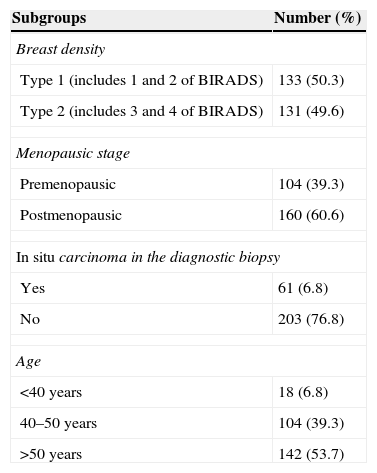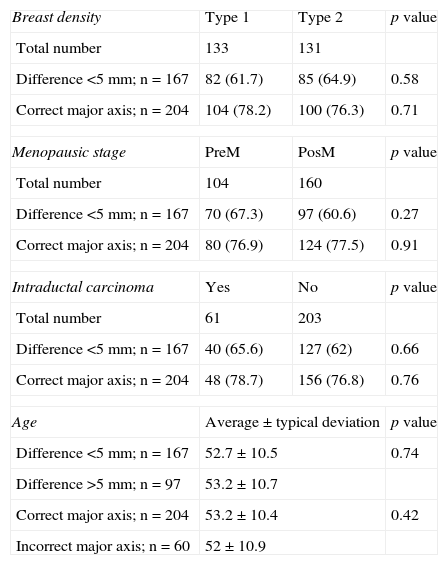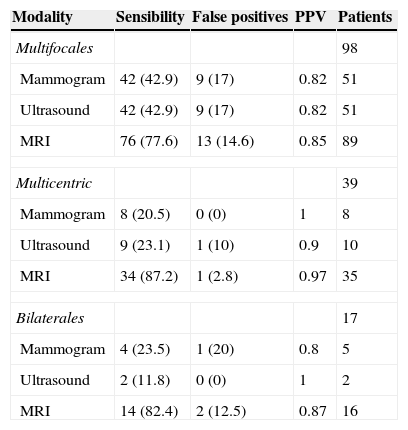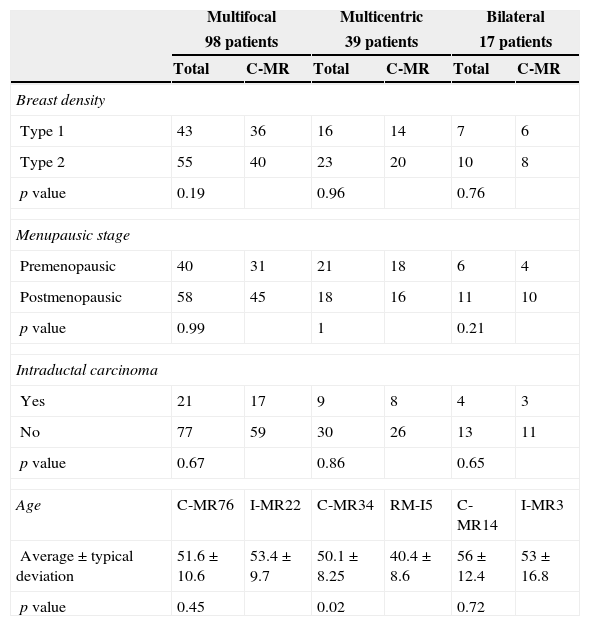To determine whether preoperative breast MRI is more useful in patients according to their breast density, age, menopausal status, and biopsy findings of carcinoma in situ.
Material and methodsWe retrospectively studied 264 patients treated for breast cancer who had undergone mammography, ultrasonography, and MRI. We compared the size of the tumor on the three techniques and the sensitivity of the techniques for detecting additional lesions both in the overall group and in subgroups of patients classified according to their breast density, age, menopausal status, and histological findings of intraductal carcinoma. The definitive histological diagnosis was used as the gold standard.
ResultsMRI was the technique that was most concordant with the histological findings for the size of the lesion, and it was also the technique that detected the most additional lesions. With MRI, we observed no differences in lesion size between the overall group and the subgroups in which MRI provided added value. Likewise, we observed no differences in the number of additional lesions detected in the overall group except for multicentric lesions, which was larger in older patients (p=0.02). In the subgroup of patients in which MRI provided added value, the sensitivity for bilateral lesions was higher in patients with fatty breasts (p=0.04). Multifocal lesions were detected significantly better in premenopausal patients (p=0.03).
ConclusionsMRI is better than mammography and better than ultrasonography for establishing the size of the tumor and for detecting additional lesions. Our results did not identify any subgroups in which the technique was more useful.
Determinar si la densidad mamaria, la edad, el estado menopáusico y el carcinoma in situ en la biopsia constituyen grupos de pacientes en quienes la RM mamaria preoperatoria es más rentable.
Material y métodosEstudiamos retrospectivamente a 264 pacientes intervenidas por cáncer de mama a las que se había realizado mamografía, ecografía y RM. Comparamos el tamaño tumoral medido con las 3 técnicas y su sensibilidad para detectar lesiones adicionales, tanto en todas los pacientes como en las clasificadas por densidad mamaria, edad, estado menopáusico o presencia de carcinoma intraductal en el estudio anatomopatológico. El estándar de referencia fue el diagnóstico anatomopatológico definitivo.
ResultadosLa RM fue la técnica que coincidió más con el tamaño anatomopatológico y mejor detectó las lesiones adicionales. Con la RM no observamos diferencias entre grupos al establecer el tamaño tanto en el total de la muestra como en el subgrupo de pacientes donde la RM tuvo valor añadido. Tampoco hubo diferencias para detectar lesiones adicionales en el grupo general excepto para lesiones multicéntricas, mayor en pacientes de más edad (p=0,02). En el grupo de pacientes donde la RM tuvo valor añadido, la sensibilidad para las lesiones bilaterales fue superior en las pacientes con mamas grasas (p=0,04). Las lesiones multifocales se detectaron significativamente mejor en pacientes premenopáusicas (p=0,03).
ConclusionesLa RM es mejor que la mamografía y la ecografía para establecer el tamaño tumoral y detectar lesiones adicionales. Nuestros resultados no identifican subgrupos donde la técnica sea más rentable.














